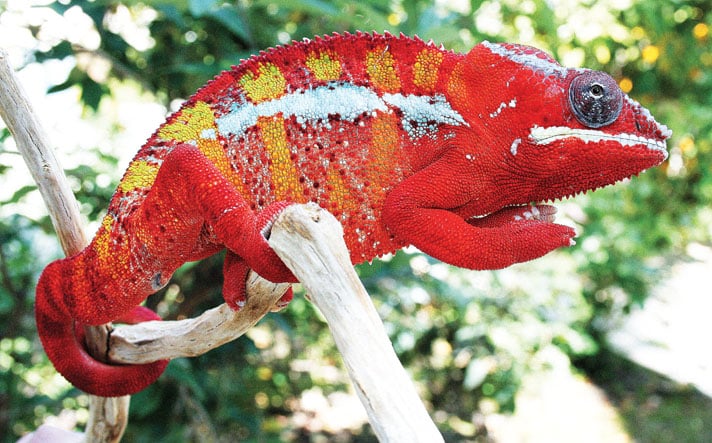Thanks to captive-breeding efforts over the years, it’s easier than ever to obtain a healthy pet chameleon.
Over the last 15 years, the popularity of the panther chameleon (Furcifer pardalis) has grown dramatically. Prized for its dazzling array of colors and interesting behavior, the panther became highly desired by chameleon hobbyists since first imported from Madagascar to the U.S. in the 1980s. The ceiling for popularity was limited at first by difficulties associated with most wild imports and a poor reputation for survival which spread as a result. It would take the advent of captive propagation and advances in care protocols to propel the panther chameleon to far broader appeal.Through the success of captive-breeding efforts, a growing number of far sturdier panthers made their way into the market. Coupled with improved care and husbandry methods, more people enjoyed a positive outcome.
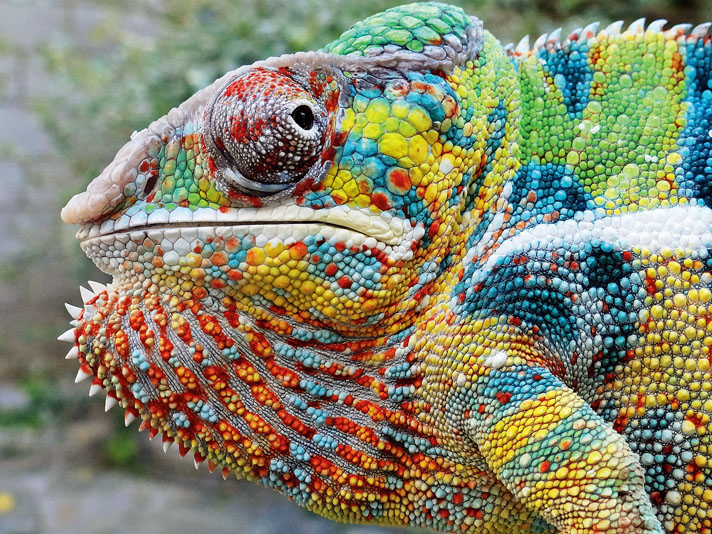
briana kammer
Thanks to captive-breeding efforts over the years, it’s easier than ever to obtain a healthy pet chameleon.
As one of the breeders who has worked with panthers the longest, I have witnessed the pre-captive-bred era and part of the renaissance that ushered them into a herpetoculture success story. The fraternity of senior chameleon keepers with 20-plus years under their belt can remember when there were only wild panthers. In stark contrast, many people in the hobby today have only known a world where CB panthers are readily available. This is a very short time frame for such an enormous and positive paradigm shift to have occurred.
Why Captive Bred Panther Chameleons?
The chameleon’s reputation for being difficult to care for was largely “earned” due to the poor condition of many wild imports and, all too often, insufficient care practices. An imported chameleon often has a variety of health issues, including internal parasites, wounds, infections, dehydration and a depressed immune system. A wild-caught chameleon’s age cannot be determined with certainty, and because of this, even an otherwise healthy individual may have a limited lifespan simply due to age.
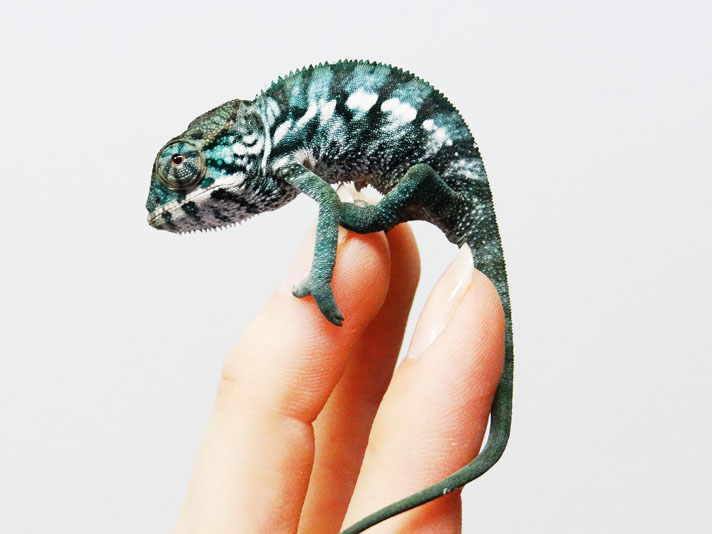
BRIANA KAMMER
This 2-month-old Nosy Be panther is already exhibiting blue coloration.
Stabilizing wild imports takes a lot of dedicated work, and even the most attentive keepers will experience their share of failures. For advanced hobbyists and breeders, caring for and acclimating an imported chameleon can be well worth the time, money and effort if there’s a desire or need for the introduction of new genes to a breeding program. In cases where the sole desire is to enjoy the thrill of owning and caring for a beautiful panther chameleon as a pet, however, without question, the supreme choice is selecting a captive-bred individual.
The potential health upgrade of a CB panther verses a wild-caught one is substantial. When well cared for, they can be quite hardy. Wild panthers in their natural habitat may live only one or two years due to the perils of predators, parasites and disease. When young, healthy, captive-bred panthers are purchased, however, you will be able to enjoy them throughout their entire life cycle. Males in captivity can average 3 to 5 years of age, with extreme exceptions of 8 and 9. Females that are well cared for and breed in captivity (which often decreases their lifespan), may average 2 to 3 years of age. Virgin females, on the other hand, have been documented to live up to eight years when freed from the toll reproduction places on their lives.
Panther Chameleon Coloration and Locales
Color is a prominent feature of the panther, and there is an abundance of beautiful and unique colors being produced. Some will be surprised to learn that despite viral videos and TV paint commercials, the panther chameleon does not change color to instantly match any background it is placed against. Panthers do exhibit color change, though, for a variety of reasons, including a method of communication, to better absorb or reflect radiant heat, and to blend in with natural habitat.
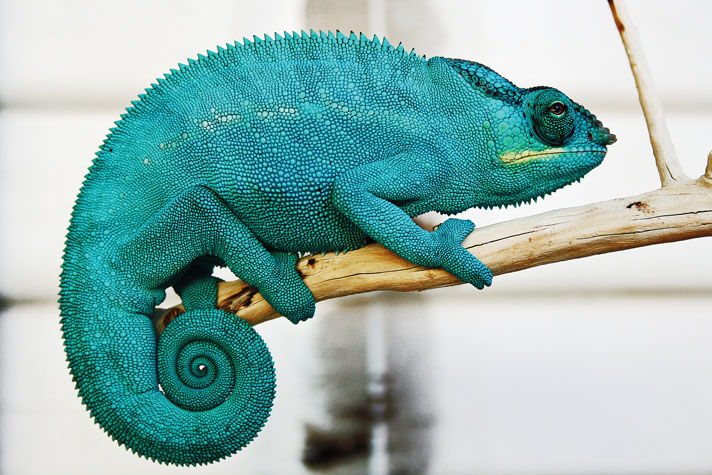
BRIANA KAMMER
Panther chameleon color can help determine where in Madagascar a chameleon may have originated, such as Ambilobe, Ambanja, Nosy Be, etc. This is Sinatra, one of the author’s Nosy Be males.
Panther chameleons are sexually dimorphic; males are larger (15 to 20 inches total length) with a wider range of colors than females. Depending on mood or visual stimulation, males may display colors that indicate a relaxed or excited state. When a male is excited and “fired-up,” he is likely sending a visual message to a rival male that he is willing to defend his turf, and to a female that he is ready for courtship.
Full-sized females are 8 to 10 inches. Mature females display softer color hues, including peach, rose or violet, when receptive to breeding. A female that is gravid or unreceptive to the amorous intentions of a male will flash highly contrasting colors, such as black in combination with red, orange or pink.
The ability to rapidly change color cannot be achieved until a panther is nearing sexual maturity. Males and females can reach sexual maturity as early as 5 months of age, but more commonly within 6 to 9 months. The range of colors an individual panther can achieve depends on where it originates from on the island of Madagascar. Population groups can vary in color and pattern from one locale to another. Names such as Ambanja, Ambilobe, Nosy Be, Sambava and Tamatave refer to cities or villages in Madagascar where panthers of a particular appearance originated. If males and females from the same area are paired, the result will be “locale-pure” offspring. If one is paired to a mate from a different region, the resulting offspring are “locale crosses.”
Want to Learn More?
The Panther Chameleon is Actually 11 Distinct Species
Panthers are normally marketed in one of three ways: as locale specific, locale cross (with the exact percentages of each region represented) or, in cases where information is lacking, as “unknown origin.” When purposefully bred, an offspring’s parentage may present some clues as to what its appearance will eventually be like as it matures.
I have witnessed rapid divergence of colors and pattern traits in some multigenerational breeding groups when compared with typical wild examples coming from the same exact locales. I am selecting for traits different than what would normally occur in nature, so it is understandable that after many years, there would be some exciting rewards. Our oldest lines are F7, representing up to 11 breeding generations here at Kammerflage.
Cage Selection and Size for Panther Chameleons
Our preference for panthers is all-screen cages or cages with at least two screened sides (front/top, side/top) with otherwise solid walls. The advantages are increased water evaporation, lighter weight and the ability to achieve a warm basking spot without overheating the entire environment. If you heat or cool your home the air can become quite dry, and chameleon cages featuring solid side and back walls can help maintain humidity within the cage while preventing misted water from getting on your walls and furniture.
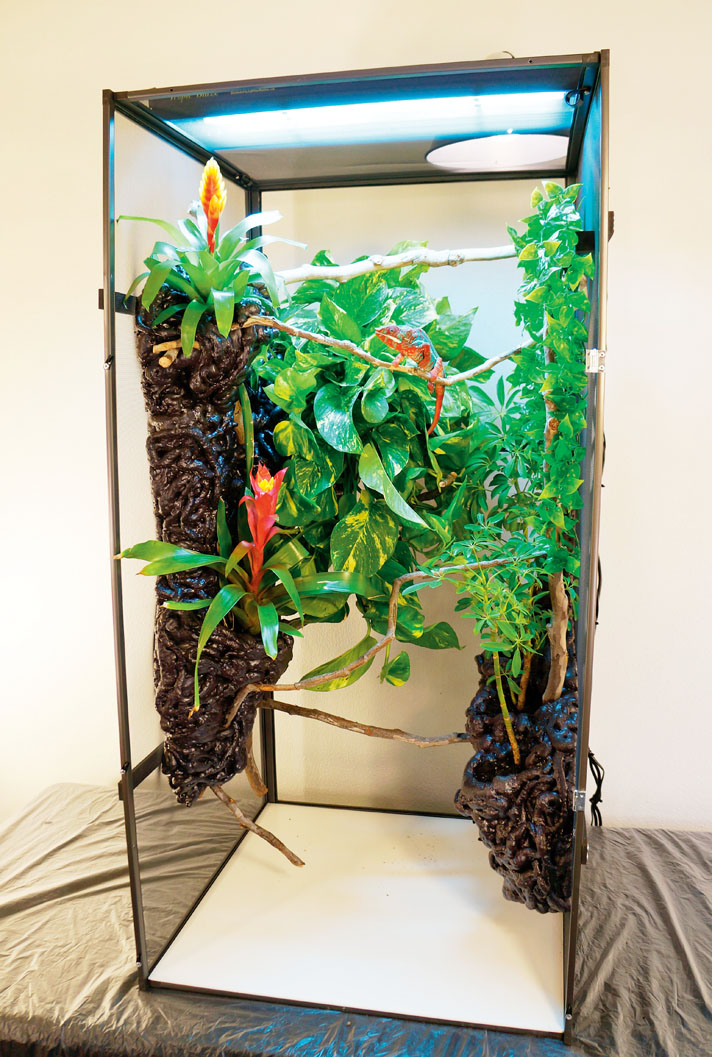
BRIANA KAMMER
Plenty of vegetation, real or artificial, is a must for any proper panther chameleon enclosure.
Cage size should be based on the age and sex of your panther. My preference for a permanent enclosure—one that can house a young chameleon for its entire life—is the Dragon Strand Medium Atrium cage, which measures 28½ by 18 by 29½ inches. For a less-expensive alternative for a panther’s initial home, I recommend an enclosure no less than 18 by 18 by 36 inches. A cage this size can also serve as an adult female’s permanent home, but a male will eventually need something larger.
Inside the Panther Chameleon Cage
Panthers are shrub and tree dwellers, so the captive environment must accommodate a life spent primarily above ground. It should appear lush, but not overgrown. There should be plenty of climbing paths made of branches, vines and/or plants. Plants play a critical role in providing a sense of security, so be sure one or two “areas of refuge” are provided.
Live or artificial plants can be used; the panthers will happily thrive among either. Live plants provide a more natural appearance and offer some humidity benefits. Some safe live plants commonly used are weeping fig trees, umbrella trees and Pothos.
It is imperative to properly clean live plants of any deadly pesticides before placing them in the habitat. Failure to do so can quickly kill your chameleon! Properly preparing a live plant will require repotting it with natural potting soil and washing all the leaves to remove any pesticide residue. To complete this one-time procedure, squeeze some antibacterial dish soap into a 5-gallon bucket and fill it with tepid water. Take the re-potted plant, still in its pot—cover the soil with aluminum foil to prevent it from falling out—and lower it upside down into the sudsy water. Swish the plant leaves in the soapy water, remove it, and allow the plant to sit for 10 minutes so the soap can break down any poisonous residue. Then rinse the leaves thoroughly in the same fashion, but using a bucket of clean water. Repeat the entire process two more times. Remove the foil and place some smooth stones on top of the soil to prevent feeder insects from burrowing into it. Your chameleon’s clean plant is now ready to be placed inside the enclosure.
Artificial plants are readily available, simple to use and easily disinfected. They also have the advantage of being arranged and placed in the exact positions desired within the environment. You will not get the humidity benefit that live plants offer, but humidity can be effectively managed by other means. We have used a variety of artificial plants from Zoo Med and Exo Terra with great results. Silk plants sold in craft stores are not recommended; they are not water proof, and may be manufactured overseas using materials that may be unsafe for reptiles.
Secure branches and vines without damaging your chameleon’s screen enclosure using Dragon Ledges (from Dragon Strand Cages). Seek branches that meet the unique gripping requirements of the panther’s zygodactyl feet (Kammerflage offers safe, natural branches cut to fit most standard-size chameleon cages, pre-sanitized for immediate use). If you use branches from outside, they must be clean and from non-toxic, “non-sappy” trees.
Heat and Light for Your Panther Chameleon
In our chameleon facility, we maintain an ambient daytime temperature of 75 degrees Fahrenheit, with a basking spot of 88 to 95 degrees in each enclosure. Nighttime temps are 70 to 75.
Locate the basking light on top of or suspended over one corner of the cage. Position a branch or vine directly below it, at a distance to achieve the proper basking temperature. As young panthers grow, the same perch that was once a safe distance from the heat source may become too close, so adjust as required. Monitor all temperatures with a thermometer, and watch for seasonal fluctuations. If your home gets cooler than 68 degrees at night, use a ceramic heat emitter to raise the nighttime temperature.
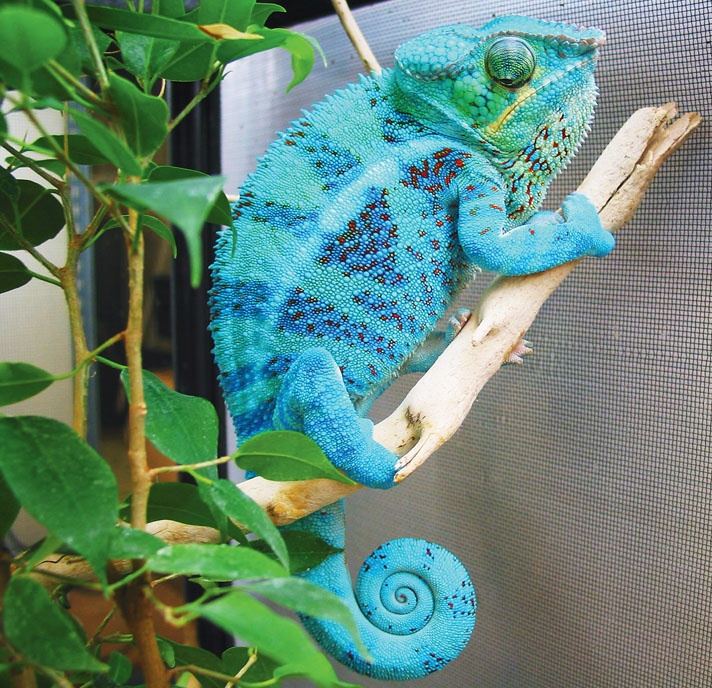
BRIANA KAMMER
Misting via an automated system is recommended, but don’t let water pool too long in the bottom of the enclosure. This is an Ambanja panther.
A separate UVB light is necessary. We recommend the Zoo Med Reptisun 5.0 T8 linear fluorescent tube, with a branch or vine positioned 6 to 7 inches directly below it. If you choose another lamp type, pay close attention to manufacturer instructions, and be aware that results may differ. Lights should be on a 12-hour day/night cycle utilizing a timer. It is important that all lights are off when it’s time for your chameleon to sleep.
Water For Your Panther Chameleon
Water provides panther chameleons with three critical benefits: hydration, adequate relative humidity, and a way for them to keep their eyes clean. Providing them with water requires a different approach than with most terrestrial lizards. With very rare exceptions, panthers will not reliably drink from water dishes. Instead, they are attracted to water that moves and/or glistens. We provide this by misting and dripping the enclosure foliage, either manually or automatically. While many keepers I have known over the years have succeeded using a manual approach, I prefer automation. A good automatic rain system can provide humidity spikes and hydration throughout the day, even when you are away from home. If you choose to automate, research the available rain or mist systems on the market to see which one fits your panther’s needs the best. Mist King, Exo Terra and Zoo Med all offer rain systems that vary in price and offer their own unique features.
Panthers should be provided the chance for a thorough drink at least twice a day by setting the duration on two or more mist cycles for up to five minutes (depending on the output of your system), or by using a Zoo Med Little Dripper twice a day, dispensing the water at one to two drops per second.
Water must drip or collect on plant leaves that are easily reached by your chameleon. With automatic misting systems, you can set multiple short cycles that provide humidity spikes throughout the day. The cage should not remain continuously wet, so allow for dry periods in-between misting cycles. Use a humidity gauge to check that your ambient humidity stays around 50 percent, with several spikes over 75 percent during the day. People who have trouble maintaining a good humidity level should consider using the Zoo Med Repti-Fogger or a cool mist humidifier placed close to the enclosure.
Managing excess water is an important health issue, and stagnant water pooling on the cage floor should be avoided. There are a few product solutions for this; our preference is the Drip Easy Drainage System from Dragon Strand, which allows water to drip through a screen cage bottom and collect in a pan beneath the cage, making maintenance much easier. Alternately, a catch container can be placed under the area where water is dripping. Whatever method you use, be sure to empty the water containers on a routine basis to avoid messes.
What To Feed Your Panther Chameleon
Purchase feeder insects from well-respected commercial growers and retailers. I don’t recommend feeding wild insects, due to their possible exposure to hazardous materials.
Keep all feeders in a clean and healthy environment. Make sure they have at least 24 hours to eat high-quality food themselves, before offering them to your chameleon (often referred to as “gut-loading”), and dust the insects with powdered supplements just prior to feeding them to your chameleon.
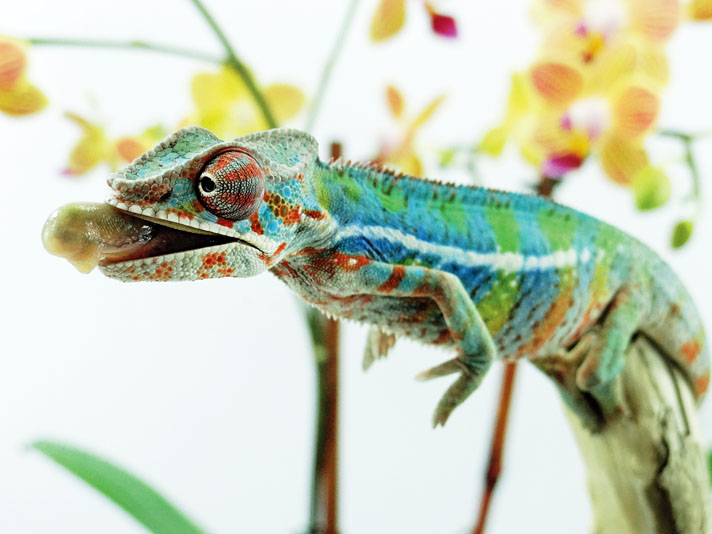
BRIANA KAMMER
Keep all feeders in a clean and healthy environment. Make sure they have at least 24 hours to eat high-quality food themselves, before offering them to your chameleon (often referred to as “gut-loading”), and dust the insects with powdered supplements just prior to feeding them to your chameleon.
Supplement ingredients and formulations vary greatly, and there are differing opinions on what works best. Again, it’s important to follow a trusted care protocol in its entirety, including supplementation. Our supplement of choice is Calcium Plus by Repashy Superfoods. It’s an all-in-one, vitamin and calcium with D3 supplement, formulated for use with every feeding. We have used it for several years with outstanding results. The “shake-and-please-don’t-bake” method is the best way to dust feeders just prior to offering.
From dime-sized hatchlings to sexual maturity at 5 to 8 months old, panthers are in a big hurry to grow up, and during this rapid growth stage, most will consume food enthusiastically. We feed all of our young panthers six days a week using the “Goldilocks” method when selecting prey size—not too big, not too little, but somewhere in the middle should be just right. There is no perfect number of prey items to offer because each chameleon’s appetite is different. Begin with a moderate amount, and if all food is consumed within 10 or 20 minutes, offer a second helping. Over time, you will get the hang of it and adjust to your chameleon’s individual intake preferences. Some chameleon keepers like to feed twice a day, once in the morning and once in the late afternoon or evening. This is perfectly fine, but keep in mind that your cold-blooded chameleon will need up to 45 minutes to warm up before and after food is offered in order to digest properly.
Many feeder insects are available. We prefer to offer one type of prey item per day in most cases, unless during a second feeding later in the day, we may wish to provide some variety. Generally, our hatchlings are offered ⅛-inch crickets, flightless fruit flies (Drosophila) and bean beetles until they’re about 6 weeks old. We withhold supplementation during their first 6 to 7 weeks of life. Two to 4 month olds are fed ¼-inch to ⅜-inch crickets dusted with Calcium Plus each feeding. They routinely consume domestic houseflies, flightless fruit flies and bean beetles as a second meal later in the day. For 5 to 12 month olds (and breeder females), we feed ½-inch to ⅝-inch crickets four days a week, and superworms, Madagascar hissing cockroaches (Dubias), silkworms or goliath hornworms the other two days.
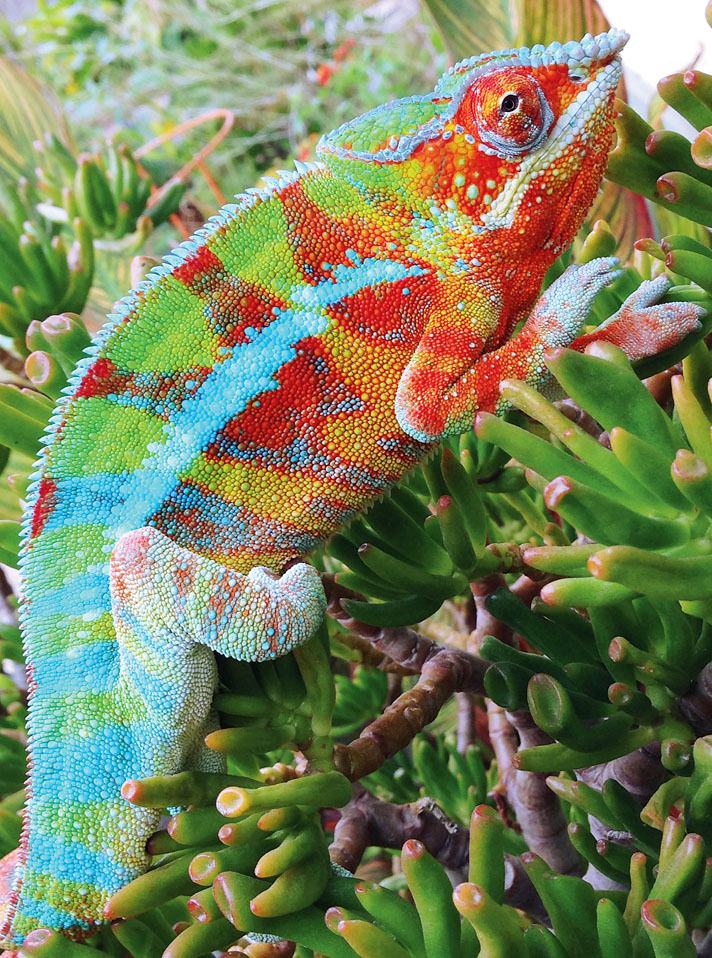
BRIANA KAMMER
Panthers are normally marketed in one of three ways: as locale specific, locale cross (with the exact percentages of each region represented) or, in cases where information is lacking, as “unknown origin.” This is a Ponzu ambanja panther chameleon.
A male panther chameleon’s rate of growth slows down at around 1 year of age, and some may become more selective as to what they will eat and how often. This frequently concerns novice keepers who are used to their young panthers being little pigs, and they think something might be wrong when their appetite changes. Unless you are seeing other symptoms of concern, this change in feeding behavior is usually normal. A good approach at this time is to alter your chameleon’s feeding schedule and offer more variety. We feed 12- to 18-month-old males five days a week, and older chameleons are fed four days a week. This modified schedule should improve feeding responses and help avoid obesity. We alternate between ⅝-inch crickets, superworms, Madagascar hissing cockroaches, silkworms and goliath hornworms, dusted with Calcium Plus each meal.
Having bred panther chameleons since 1998, I have been extremely impressed to see nearly an entire market shift away from purchasing wild-caught panther chameleons to CB animals. If you seek the thrill of owning one of the most wonderful creatures on planet Earth, now’s the right time. The care information and products are available, and amazing CB panther chameleons have never been more available. The rest is up to you.
Ed Kammer owned West Coast Reptile (a herp distributor to pet stores) from 1980 to 2005, followed by Kammerflage Kreations from 1998 to the present. He began keeping chameleons in the 1970s, but not until his wife, Liddy, fell deeply in love with them in the mid-‘90s did he find his “calling.” Pioneers in the field of chameleon breeding, Ed and Liddy have successfully bred more than 20 species, and with daughter Briana and son Travis, they now specialize in multi-generational breeding of high-quality panther chameleons for hobbyists, breeders and zoos around the world. Visit their website at chameleonsonly.com.

